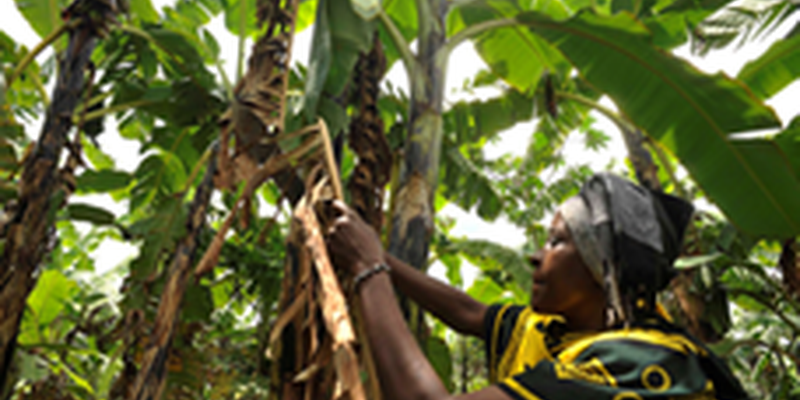First workshop held on Fusarium Tropical race 4 diagnostic
Posted on Wed, 30 Mar 2022, 08:01

© FAO/Simon Maina
Rome, 25 March 2022. The International Plant Protection Convention (IPPC) Secretariat in collaboration with contracting parties and subject matter experts launched a workshop series on Fusarium TR4 diagnostic, surveillance, inspection and simulation exercises. Fusarium oxysporum f.sp cubense Tropical race 4 (TR4), a soil-borne fungus, is currently the greatest threat to global banana production, affecting many varieties, including Cavendish bananas which provide around half of the global banana supply. The first of the three sessions, held on March 25, focused on TR4 diagnostics. Around 300 participants from 120 countries, including countries in Africa, Asia, the Pacific, Latin America, and the Near East and North Africa, attended the first virtual workshop.
"Over the past ten years, TR4 had an intercontinental jump from Southeast Asia to Africa in 2013 and South America in 2019. These are some of the world's biggest banana production areas. It makes it even more significant that we prevent the introduction and spread of Fusarium TR4," emphasized Osama El-Lissy, IPPC Secretary.
The IPPC Strategic Framework 2020-2030 addresses the issue of emerging pests by developing the Pest Outbreak Alert and Response Systems. Adding value to IPPC's efforts are the provision of guidance and training materials, made available on the IPPC's international phytosanitary portal and through upcoming outputs from specific projects.
"The IPPC has been working to prevent the spread of plant pests and diseases globally through safer international trade. The International Standards for Phytosanitary Measures, or the ISPMs, provide a set of global standards and a common understanding towards achieving this purpose. However, the risk can never be reduced to zero, so countries need to be prepared to respond to pest outbreaks and to the introduction and spread of emerging pests," El-Lissy added.
TR4 diagnostic
Diagnostic is a critical point in decision-making when responding to a pest alert or an imminent pest threat. This underscores the importance of using reliable, accurate and reproducible methodologies and techniques. Presenting at the webinar, Gert Kerma, Professor of Phytopathology in Wageningen University and Fernando Garcia-Bastidas, Head of the banana breeding program in Keygene, the Netherlands, shared the key factors to consider when executing a diagnosis of Fusarium TR4, particularly for a first report.
Diagnostics should cover the field symptoms of a suspect banana plant, the proper manner of taking a sample in the field, keeping the sample integrity, and suitable lab methodologies and techniques avoiding false positives or negatives.
Cultivar Cavendish is susceptible to TR4 but not to the Fusarium oxysporum f.sp cubense (Foc) races one and two. The main symptoms expressed in Cavendish by a TR4 infection are the same symptoms caused by races one and two of Foc in other banana germplasms that are likewise susceptible to TR4. That means characterization of symptoms doesn't serve to identify Foc races in banana plants expressing the typical symptomatology.
"Despite the fact that Cavendish is very susceptible, there are other banana germplasms that are equally susceptible to TR4, that's why diagnostic is crucial to timely identify and accurately diagnose Fusarium TR4 from a plant with the disease symptoms," Mr. Kerma stated.
The diagnostic of TR4 has evolved and the molecular techniques have shortened the time to do so. Sample processing, fungus DNA extraction and DNA quantification may be executed using different techniques and equipment that can be chosen according to the capacity and condition of the laboratory. Locally prepared reagents or commercial kits may be utilized for the above purposes.
There are molecular markers, also called primers, that allow the identification of TR4 through the execution of conventional Polymerase Reaction Chain (PCR), Real-Time PCR, and a Loop-Mediated Isothermal Amplification (LAMP) test.
"However, you cannot play too much around selecting which kind of primers you are going to use. I recommend mixing [use at least two independent primers], because sometimes some of these [primers] amplify for not only TR4, may also [amplify] subtropical race," said Mr. Garcia-Bastidas.
"A first report must follow a complete route that considers the use of PCR, qPCR or LAMP, genome sequencing, and pathogenicity tests," he added.
The Colombian NPPO experience in TR4 diagnostic
Implementing and standardizing these techniques require a deep and concise understanding of the technical and biological basis of the plant and the pathogen. National plant protection organizations (NPPOs) may find it challenging to implement and standardize the techniques at the lab.
Mariluz Ayala Vásquez, Coordinator and Analyst of the Plant Quarantine Laboratory of the Instituto Colombiano Agropecuario (ICA), shared their experience at the Colombian NPPO. She emphasized the importance of reducing the risk of locally spreading the pathogen through the sample mobilization and how they adapted their conditions to implement biosecurity practices and protocols to prevent the pathogen from spreading when "sending the samples to the laboratory and handling and disposing of the pathogen in the laboratories."
IPPC and COMESA
The IPPC and Common Market for Eastern and Southern Africa (COMESA) Secretariat have been working to build the capacity of member countries in the COMESA through developing four e-Learning courses on pest risk analysis, export certification, surveillance and inspection, and a guide on contingency planning. It was organized under the "FAO support to COMESA trade facilitation programme", with support from the Comité de Liaison Europe-Afrique-Caraïbe-Pacifique (COLEACP) and the Latin-American and Caribbean Economic System (SELA).
The second session of the workshop series on surveillance and early warning is scheduled for 19 April 2022. The third session on inspection and simulation exercises is scheduled for 10 May 2022. Registration links for both sessions are available here.
Presentation and recording of the first session can be viewed at the webinar webpage here.

